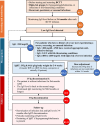Evidence- and Consensus-Based Recommendations for the Screening, Diagnosis, and Management of Secondary Hypogammaglobulinemia in Patients With Systemic Autoimmune Rheumatic Diseases by the Taiwan College of Rheumatology Experts
- PMID: 40522036
- PMCID: PMC12169084
- DOI: 10.1111/1756-185X.70310
Evidence- and Consensus-Based Recommendations for the Screening, Diagnosis, and Management of Secondary Hypogammaglobulinemia in Patients With Systemic Autoimmune Rheumatic Diseases by the Taiwan College of Rheumatology Experts
Abstract
Secondary hypogammaglobulinemia (SHG) is characterized by reduced serum immunoglobulin (Ig) levels and is typically caused by immunosuppressive therapy or certain diseases. Patients with systemic autoimmune rheumatic diseases (SARDs) and hematological malignancies are particularly susceptible to developing SHG due to underlying diseases and the use of immunosuppressive medications, such as B-cell-targeted agents. Consequently, SHG significantly contributes to increased risks of severe infections and mortality in SARDs patients. Considering the lack of a unified strategy for managing SHG, the Taiwan College of Rheumatology (TCR) aimed to formulate consensus recommendations for the screening, diagnosis, and management of SHG. These recommendations were developed based on emerging evidence during a face-to-face meeting of the TCR committee (nine immunologists and rheumatologists), and utilizing the modified Delphi process. This meeting involved a comprehensive review of the current evidence, using the Grading of Recommendations, Assessment, Development, and Evaluation (GRADE) methodology. Thirteen consensus recommendations were developed to emphasize the importance of early detection and optimal treatment of SHG. Furthermore, effective prevention of infections through risk assessment alongside timely and regular monitoring of IgG levels was highlighted. The recommendations also included anti-infective therapies and intravenous Ig replacement, offering valuable guidance to rheumatologists in managing SHG. This consensus will be regularly updated as newer evidence emerges.
Keywords: B‐cell‐targeted therapy; consensus recommendations; immunoglobulin replacement therapy; immunosuppression; infection; secondary hypogammaglobulinemia; systemic autoimmune rheumatic diseases.
© 2025 The Author(s). International Journal of Rheumatic Diseases published by Asia Pacific League of Associations for Rheumatology and John Wiley & Sons Australia, Ltd.
Conflict of interest statement
The authors declare no conflicts of interest.
Figures


Similar articles
-
OARSI recommendations for the management of hip and knee osteoarthritis, part I: critical appraisal of existing treatment guidelines and systematic review of current research evidence.Osteoarthritis Cartilage. 2007 Sep;15(9):981-1000. doi: 10.1016/j.joca.2007.06.014. Epub 2007 Aug 27. Osteoarthritis Cartilage. 2007. PMID: 17719803
-
NIH Consensus Statement on Management of Hepatitis C: 2002.NIH Consens State Sci Statements. 2002 Jun 10-12;19(3):1-46. NIH Consens State Sci Statements. 2002. PMID: 14768714
-
Home treatment for mental health problems: a systematic review.Health Technol Assess. 2001;5(15):1-139. doi: 10.3310/hta5150. Health Technol Assess. 2001. PMID: 11532236
-
Methodology for the systematic reviews on an evidence-based approach for the management of chronic low back pain.Spine (Phila Pa 1976). 2011 Oct 1;36(21 Suppl):S10-8. doi: 10.1097/BRS.0b013e31822ef8ee. Spine (Phila Pa 1976). 2011. PMID: 21952182
-
Immunomodulatory treatment other than corticosteroids, immunoglobulin and plasma exchange for chronic inflammatory demyelinating polyradiculoneuropathy.Cochrane Database Syst Rev. 2017 May 8;5(5):CD003280. doi: 10.1002/14651858.CD003280.pub5. Cochrane Database Syst Rev. 2017. PMID: 28481421 Free PMC article.
References
-
- Otani I. M., Lehman H. K., Jongco A. M., et al., “Practical Guidance for the Diagnosis and Management of Secondary Hypogammaglobulinemia: A Work Group Report of the AAAAI Primary Immunodeficiency and Altered Immune Response Committees,” Journal of Allergy and Clinical Immunology 149, no. 5 (2022): 1525–1560, 10.1016/j.jaci.2022.01.025. - DOI - PubMed
Publication types
MeSH terms
Substances
LinkOut - more resources
Full Text Sources
Medical

